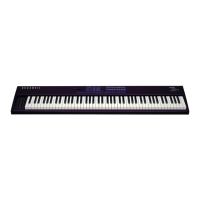2-12
Getting Started
The Front Panel
Each character in the display also has a small dot at the bottom right. If these dots are
on, it means that the current setup has been edited but the change has not yet been
made permanent by storing it into memory.
Mode LEDs
The two fundamental modes of the Stage Piano are Internal Voices mode and MIDI
Setups mode. The mode LEDs above and below the display indicate which mode is
current. One of them will always be on. Internal Voices Play mode is always selected
when you Þrst turn your Stage Piano on.
Parameter Editing Buttons
The 4 parameter-editing buttons are to the left of the display; most of them have dual
markings. The top marking is active when in Play mode and the bottom marking
when in Edit mode. One exception is Row Select, whose single marking is for Edit
mode. The Play/Edit button is used to shift between Play mode and Edit mode.
The Parameter Display
Your Stage Piano has a total of 30 parameters, whose values determine sound selection,
effects, what the player controls do, keyboard split, and a host of other options. The
active parameter is indicated by 8 LEDs arranged around a list of the 30 parameter
names.
The 30 parameters are arranged into 3 columns. The two column-designator LEDs
identify the active column as follows:
Left column LED on Left parameter column is active
Right column LED on Center parameter column is active
Both column LEDs off Right (global) parameter column is active
Each column of parameters has 6 rows of (usually) two paired parameters each.
Each column of parameters consists of 6 rows, with two parameters for each row
(except for the Effect parameter). There is a row-designator LED for each pair. If the
row LED is on continuously, the upper parameter of the pair is active. If the row LED
is blinking, then the lower parameter of the pair is active. The LED for the Efect
parameter (left column, 4th row) always lights continuously when the Effect
parameter is selected.
Use the Col Select and Row Select buttons to navigate to the parameter that you want
to view or edit.
The Info Strip
This long strip below all of the buttons, LEDs, and display contains useful reference
information. Most of the strip tells what each of the 128 possible MIDI destination
numbers does. The remainder lists the 10 effects by number and name. Chapters 3
and 4 tell you how to use the information on the strip.

